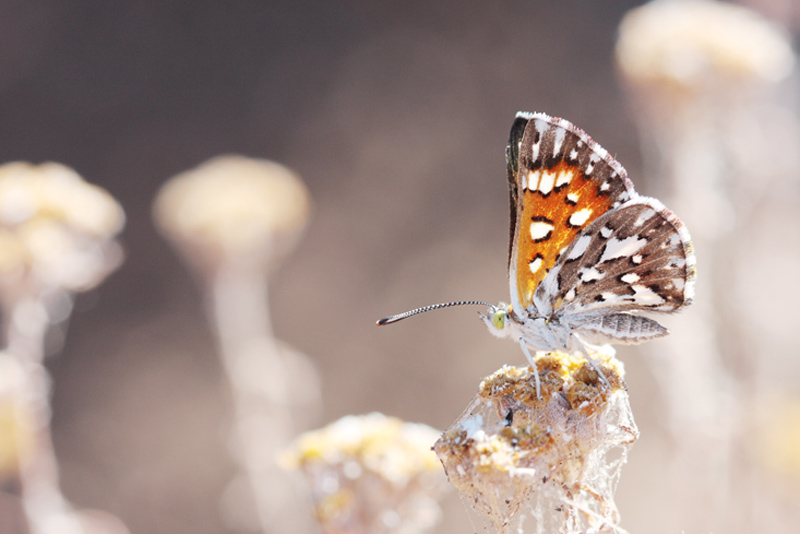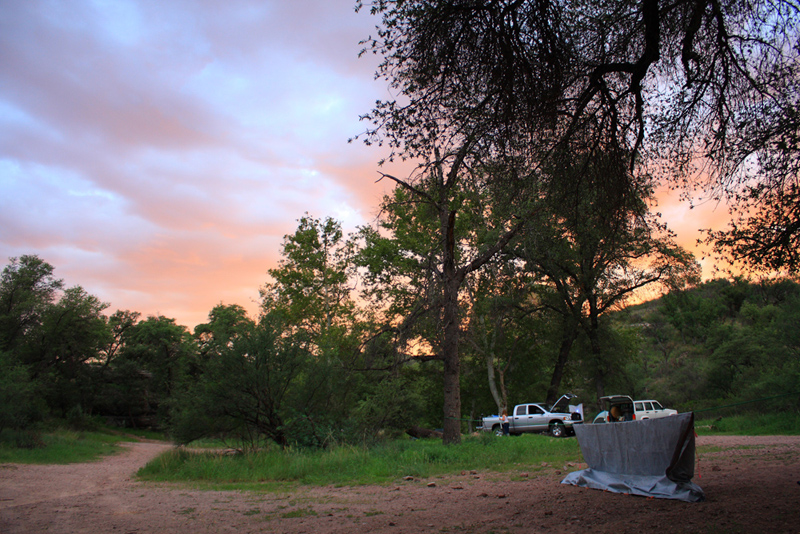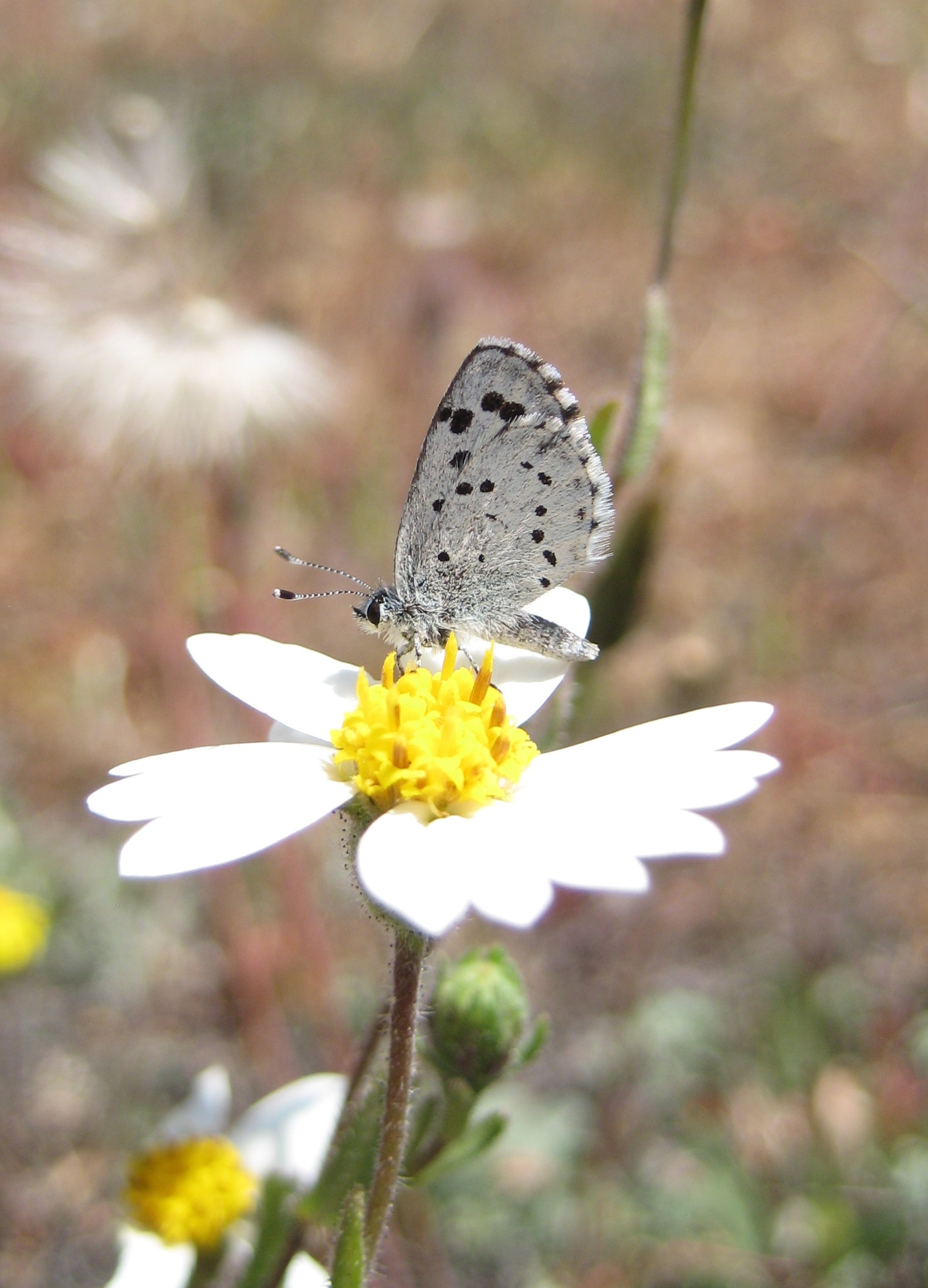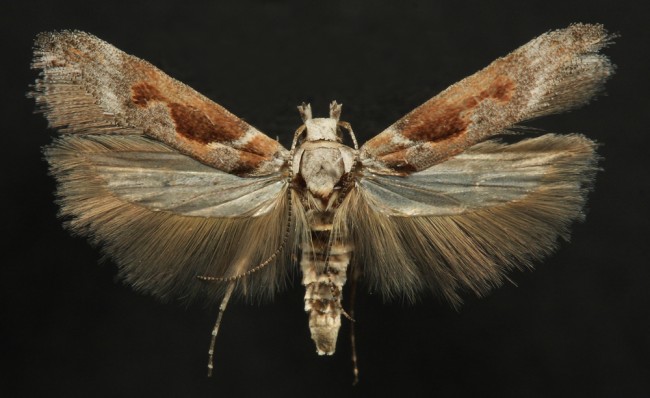クリスGrinterによって, on February 24th, 2010

Know this butterfly? It’s OK, no one really does. It is in the genus Apodemia (Riodinidae), but the taxonomy of this group is a disaster… and don’t even get me started on the subspecies. This specimen was photographed in September, meaning it is most likely to be Apodemia mormo (mormo) based on flight time. A. mormo is a fall flyer and A. virgulti is a spring flyer. While some forms seem distinctive, there is massive morphological overlap and they are usually identical and sympatric – actually down to living on the same plants. But according to lab experiments it is impossible to get the pupae to break diapause so they remain reproductively isolated. So are they different? While molecular work is being conducted the verdict is out, but it does seem like these two species may be retained in the end. そしてもちろん, each mountain range has it’s own subspecies. Who knows, I sure don’t. I’m glad I don’t work on butterflies.
Species concepts are a fuzzy line and it’s never clear exactly where to make the cut. When asked what a species is most people default to the Mayr concept of Biological Species (BSC), where reproductive isolation = new. This is all well and good but we have to keep in mind that this is not the ONLY species concept. があります 数十, and not one is perfect. Groups like Grammia (ヤガ科: ヒトリガ科) exhibit high levels of hybridization, which does not adhere well to the BSC. I like to apply as many criteria as possible to delimit a species and it seems like the line is all too commonly thin within insects. I like to see a distinguishing morphological trait, if not in wing color or pattern, at the least in the genitalia or antennae. This is not always the case however and you have to look at the biology and/or DNA. I have looked at two insects that are for all intents and purposes identical. But the biology is radically different and a large % difference (オーバー 8% – はい, arbitrary) in their DNA makes it unquestionable that they are separate.
And if species weren’t contentious enough subspecies stir the pot even more. I’m skeptical about the entire concept, but there are cases in which it seems plausible and necessary. A subspecies is a more formal definition of a geographical “形” and usually exhibits a blend zone into another subspecies. For instance if you look at the 27 different populations of Plebejus icarioides there are large differences between northern and southern populations, but very subtile difference along the gradient. It is that persistent gradient that creates one dynamic species instead of 27 separate species – at least according to current research. Moths have been lucky and have thus far avoided the plague of over-subspeciation, butterflies not so much. There may even be instances where greedy collectors have named new subspecies of Parnassius for profit (new rare butterfly subspecies sell for big bucks).
The truth is that species concepts are artificial, poorly understood and dynamic at best; at worst it approaches a soft science with no real possibility of proof. Yet species are real and theories will continue to adapt while we sit here and scratch our heads.
クリスGrinterによって, 2月23日に, 2010 

昆虫学者であることの特典の一つは、旅行や収集している. 私は毎年夏に車に数千マイルを入れて、これらを収集するためにアリゾナ州の最高の場所の二つで. トップ画像はBaboquivari山脈からのものである (途中でBaboquivariピーク), ブラウンキャニオン研究ステーション. The bottom image is of Pena Blanca Canyon, a famous collecting hotspot. This canyon is just 5 miles from Mexico and has a few safety concerns because of our current immigration policy. One morning, while sorting moths from the previous nights catch, a colleague and I had a group of roughly 30 illegals walk right through our camp. They were well dressed and clean, waved, and must have just been dropped off at the fence. Thankfully the majority of illegals are hard-working and honest people trying to earn a better life. It’s the coyotes and smugglers that are scarier – I have heard tales of Mexican police escorting drug caravans into the US with heavy artillery. And just last year a border patrol agent was stabbed to death by a coyote in this vicinity.
ありがたいことに, a bunch of strange guys standing around strange lights at nights grants us a wide berth.
(Are these images small enough to load quickly?)
クリスGrinterによって, 2月23日に, 2010 蝶ではかなり無関心にもかかわらず, 彼らは見てかなりある. ここで私は、南カリフォルニアでダウンを知っている人によって本当に素晴らしいビデオです. 鱗翅目のライフサイクルの彼の時間経過動画はかなり印象的です, 特にこの1は美しい. あなたが約にカットした場合 3:00 で, あなたは偉大なパープルHairstreaksの数十が表示されます (Atlides halesus) 彼らのさなぎから出てくる, 色は素晴らしいです. この蝶は、SWとメキシコが原産です, と私はフィールドでそれを見つけるのが大好き認めざるを得ない.
[youtube = http://www.youtube.com/watch?v=KyWJlpIchkE]
クリスGrinterによって, 2月23日に, 2010 ライナス·ポーリングとビタミンCについての簡単なコメントは、以下の私は、このビデオは最初のことでしばらく前に掲示覚え製 Pharyngula. これはケイリー·ンマリスです, PCR法の発明者, ノーベル賞受賞者. 彼の発明は、基本的にはDNA解析可能にした. しかし、ポーリングのような, 彼はまた、完全に、完全にナッツです. あなたは彼散歩に耳を傾ける時間があれば, 試してみる. しかし、短期的に, 彼は占星術について説明します, 地球温暖化を拒否し、どのようにエイズは、HIVによるものではありません. 私は、統計が彼らのロッカーから滑り落ち天才科学者のためのものだろうか?
[Vimeoの 9167379]
クリスGrinterによって, 2月22日, 2010 
これは私の古いイメージです, ので、それは完璧ではない. この蝶を種に教えてくれれば、ハイタッチができます. あなたが亜種を知っているなら, 新しいパックをお送りします #3 ステンレス鋼のピン! ヒントのみ: アメリカ西部からです.
クリスGrinterによって, 2月22日, 2010 Today I found この article in NY times health – 妊娠中の女性のうつ病の救済のために使用される鍼の利点を宣伝. 私はジャーナリストでいくつかの問題を抱えている, シャーリーS. マネー, 彼女の作品に懐疑的に失敗. しかし、これは驚くに当たりません, so I won’t bother to point out obvious flaws in the media.
I will point out the flaws in the study. Please find the original full text, ここで. So after reading this paper I have come to a few conclusions.
1) Very small sample size of 150 patients, 唯一の 141 treated.
2) The study is blinded ONLY for the depression scoring, not administration of acupuncture. In fact, their release form states “Participants in one of these two groups will receive acupuncture that focuses on depression symptoms and the other treatment will not.” Makes sense, getting a needle shoved in your skin is easy to notice. そう, these “randomized and blinded” participants knew what was coming and assumed that any poking was supposed to help their depression. さらに, この (much better) study has shown that simulated acupuncture with toothpicks works just the same. Careful, this is compelling evidence against the validity of acupuncture – not evidence for the usefulness of stimulated “pressure points”. It is a placebo effect.
3) Study assumes validity of “depression specific” と “non-specific” acupuncture. Meaning one method of pin sticking somehow cures depression over another. What is this based on? Oh wait, they say exactly the exhaustive scientific evidence right here: “patterns of disharmony according to the principles of traditional Chinese medicine”. I’m sorry, お願いします, give me modern medicine over 2,000 year old mythical beliefs. How was the average quality of life and life expectancy for an ancient chinese person? Pretty damn horrible, and I’m sure the average life expectancy did not exceed 35 年.
4) Basing depression scores on one administration of the DSM-IV Hamilton Rating Scale. Not being a psychiatrist I can’t speak to the efficacy of these tests. しかし, I will go out on a limb and assume that a stronger baseline for depression should be established before comparing results. The test may be accurate, but why not administer it more than once to reduce noise.
5) Selection of massage as a second control. This is a bad attempt at token skepticism, they even state right off the bat “Massage was conceptualized as a control treatment because, although it improves mood immediately after a session, there is insufficient evidence to support its efficacy as a treatment for depression.” When I design a study I like to look at all known factors that I believe will disprove my hypothesis. Choosing something that you already believe will fail only shows their hand of gross bias.
6) Failure to control for socioeconomic factors. 67% of the participants were white, the majority of which were well-educated. They even go as far as to state in the discussion “したがって, results might not generalize to specific minority groups that were underrepresented in our sample”. Is it just me, or does this statement negate the entirety of their research? They are freely admitting that acupuncture might not work as well in other minority groups. Why could this be? The only logical and scientific answer is that a placebo effect differs across socioeconomic boundaries. If, 結局, acupuncture was a legitimate medical science, there would be an insignificant difference seen across physiologically identical organisms.
This study is appallingly bad science. These researchers are beginning with the premise that acupuncture works, and searching for data to support their claims. This is exactly opposite of how to conduct real science. そして, our health reporter at the NY Times didn’t even bat an eye. Fail for you Mrs. マネー, and fail to the NY Times.
クリスGrinterによって, 2月21日, 2010 私は、午前 3 時のテレビ視聴者と同じくらい、ミン・ツァイと彼の料理帝国が大好きです. 実際に, his recipes are fantastic and you should make them yourself. しかし、私は彼がこう言う奇妙な傾向に気づきました。 (言い換えた) “常にオーガニックを使用する必要があります, それはあなたにとってずっと良いことです”. これには少し困惑してしまいます. What exactly does he mean? Ming is well-educated and this is not anything he should be solely responsible for, but he echoes an all too common misconception that organic is actually better. By better I am interpreting this as healthier, which seems to be a logical gap to bridge. そう, let’s look at the data.
A recent and comprehensive review published in the American Journal of Clinical Nutrition has largely convinced me of what I was always skeptical of; that organic foods can not actually be healthier for you. In their breakdown they cited 55 studies and came to the conclusion that “there is no evidence of a difference in nutrient quality between organically and conventionally produced foodstuffs”.
So what is the harm? My problem with all of this is that it is based on the naturalistic fallacy, その “natural” または “organic” somehow means that the product is safer or healthier. How many times do you see the term “natural” in the store and never give it second thought? If natural things really were safer then traditional Ayurvedic medicines would not be horribly toxic. Afterall, arsenic, lead and mercury are NATURAL – but they are also some of the most toxic compounds known to man. In the end it is 100% marketing.
Taken from another angle Ming Tsai may not be all that incorrect afterall. I do not have all the data in front of me regarding pesticide contamination of foodstuffs, but it is logical to assume the less contaminated the better. Obviously pesticides can be a bad thing, there are mountains of literature to support the damage they can cause. But the jury seems out on exactly how bad, if at all, these minute residues on our foods are. Conventionally grown foods have regulated levels of residues, but even organics are not free of pesticide contamination. So I look at it differently. Our environment benefits from having safer food. Less chemicals are dumped into our waterways, farmers have to battle less with incredibly powerful toxins, と blinky the fish fights to see another day. We should all strive to live sustainably and organic farming does provide us with an edge.
So once again, what is the harm? People who buy organic quite possibly do so based on genuine environmental stewardship. I would also argue that a very high percentage of these people also believe these foods are healthier (anyone have survey data to support this claim?). So in this instance the result is a net positive. しかし, being right for the wrong reasons should never be acceptable. This strikes at the peak of a larger problem that is driven by marketing and zero science. Case in point – Vitamin C as a cold remedy. A study in PLOS medicine has shown there is no indication for efficacy of VitC against the common cold. 図に行く, a once believed to be true staple has begun to be picked apart by science and data. Let’s be careful on what bandwagon we jump and why.
クリスGrinterによって, 2月21日, 2010 [youtube = http://www.youtube.com/watch?v=zSgiXGELjbc]
私は本当にこの自動チューニングセーガンを楽しむ, 私がこの雄弁だったで私を作る. ここでより多くのビデオを見る 科学のシンフォニー.
クリスGrinterによって, 2月21日, 2010  そう, 私は新しいブログを始めるんどのように? 厳しい質問, おそらくこれは楽しい新しい種を披露する良い時間です. この蛾はサンタバーバラの外で昨年採取した, カリフォルニア州. 巨大な翼幅, 15ミリメートルで, Gelechiid蛾のためにそれはかなり大規模になる. 属, Gnorimoschema (ノル·モッシュ-MAと発音), 現在知られているよりもはるかに多くの種が豊富なようです, だからこの生き物は当然のことです. それはまた私にそのような素晴らしく多様な動物のグループを研究することの利点について自慢する機会を与えてくれます. 運が良ければ私の友達になることができます。おそらくいつか自分の種を手に入れるでしょう。. そう, 私は新しいブログを始めるんどのように? 厳しい質問, おそらくこれは楽しい新しい種を披露する良い時間です. この蛾はサンタバーバラの外で昨年採取した, カリフォルニア州. 巨大な翼幅, 15ミリメートルで, Gelechiid蛾のためにそれはかなり大規模になる. 属, Gnorimoschema (ノル·モッシュ-MAと発音), 現在知られているよりもはるかに多くの種が豊富なようです, だからこの生き物は当然のことです. それはまた私にそのような素晴らしく多様な動物のグループを研究することの利点について自慢する機会を与えてくれます. 運が良ければ私の友達になることができます。おそらくいつか自分の種を手に入れるでしょう。.
一方, これも問題を浮き彫りにします – 私たちの惑星で最も多様な動物のグループについてほとんど何も知りません. 新しい作物が小さな人に食べられているとどうなりますか, わかりにくい, 蛾? あなたを助けることができるかもしれない世界の十数人の一人に電話してください. 多分彼らはそれが何であるかを知っています, しかし、おそらくその生物学については何も知られていない. これはで起こったことです サウス・ダコタ 最近、バイオ燃料作物が最後に見られた蛾に食べられていたとき 1910. より多くの資金を調達するための完璧な理由! 上記の私の新しい蛾が害虫に爆発することはないでしょう. しかし、この地球を私たちと共有する種の基本的な知識を持つことは、正しい方向への一歩です.
|
懐疑
|





